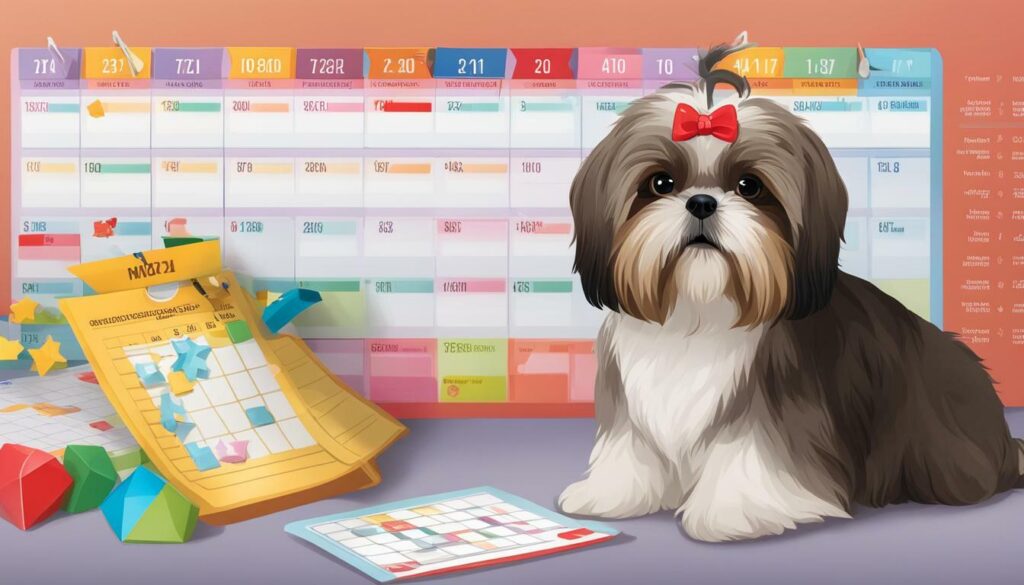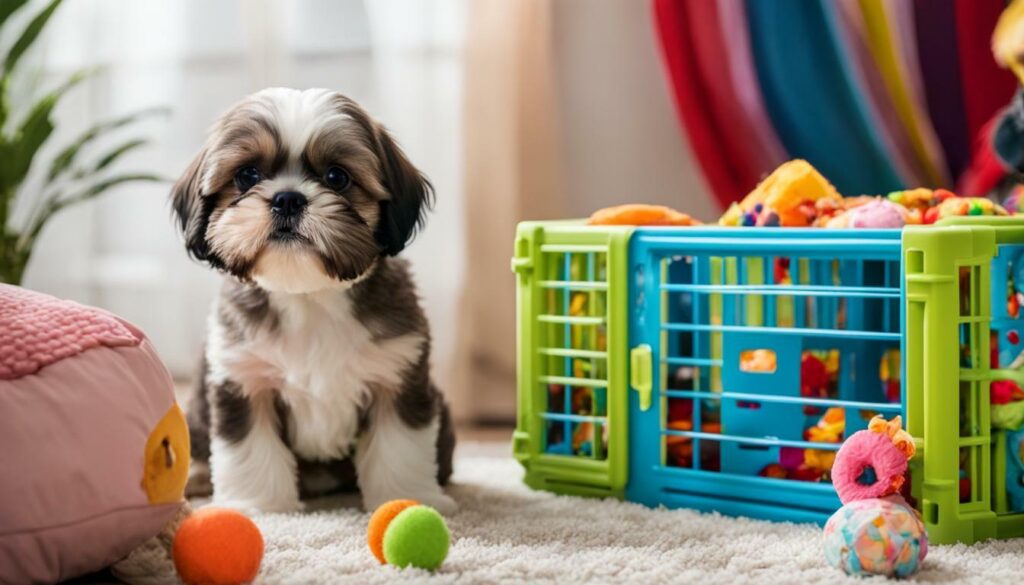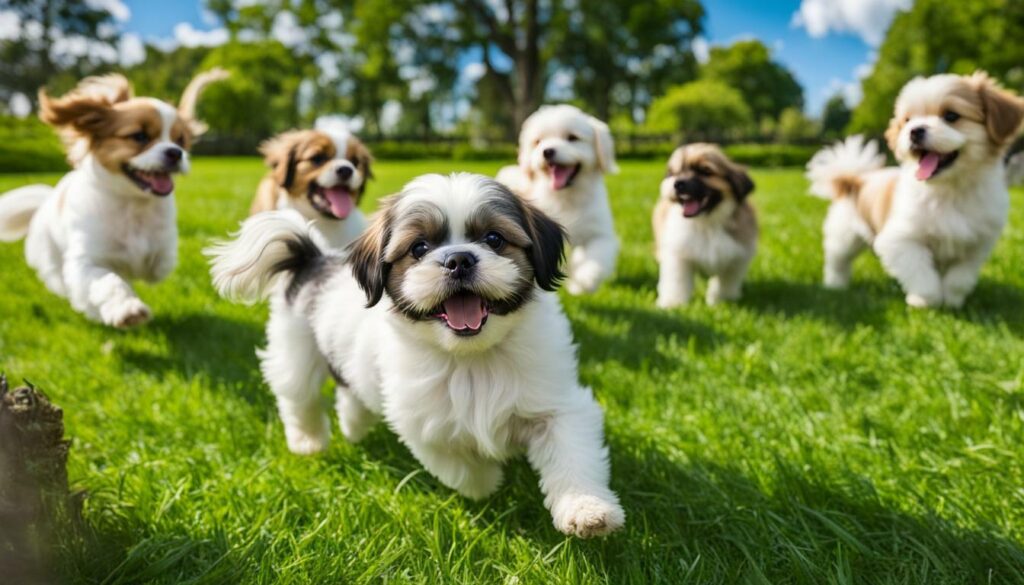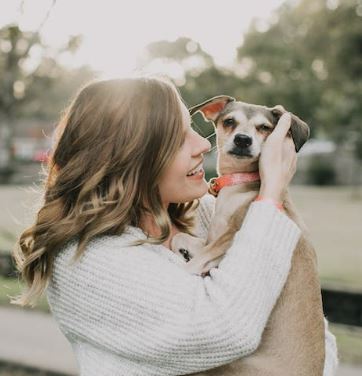Welcome to the complete Shih Tzu Training Guide, a resource that will help you train your pet with love and achieve a strong bond with your furry friend. Whether you’re a beginner or have experience with dog training, this guide will provide you with comprehensive information and practical tips on raising and training a Shih Tzu.
- Training your Shih Tzu with love and patience is key to building a strong bond.
- Crate training is an important aspect of Shih Tzu training and can provide a safe and secure space for your dog.
- Choosing whether to train your Shih Tzu to eliminate inside or outside requires careful consideration of your lifestyle and your dog’s needs.
- Establishing a consistent training schedule will help your Shih Tzu learn and reinforce good behaviors.
- Teaching your Shih Tzu to come when called and leash training are essential for their safety and enjoyable walks.
By following the techniques and tips outlined in this guide, you will be equipped to raise a well-behaved and happy Shih Tzu. Remember, training should always be approached with love, patience, and positive reinforcement.
Shih Tzu Training Tips for Beginners
If you are a beginner in Shih Tzu training, don’t worry! This section will provide you with valuable tips to get started on the right foot.
1. Establish a positive and loving relationship: Building a strong bond with your Shih Tzu is crucial for successful training. Use positive reinforcement techniques such as praise, treats, and playtime to motivate and reward your furry friend.
2. Be patient and consistent: Remember that training takes time and effort. Consistency is key when teaching your Shih Tzu new commands or behaviors. Repeat training sessions regularly and use the same cues and rewards to reinforce learning.
3. Start with basic commands: Begin with simple commands like sit, stay, and come. Break the training process into small, achievable steps, and gradually increase the difficulty level as your Shih Tzu progresses.
4. Socialize your Shih Tzu: Expose your dog to different environments, people, and animals from an early age. This will help them develop good social skills and become well-rounded companions. Use positive reinforcement to reward calm and friendly behavior during socialization.

Shih Tzu Training Tips for Beginners Summary:
| Tips for Beginners |
|---|
| Establish a positive and loving relationship |
| Be patient and consistent |
| Start with basic commands |
| Socialize your Shih Tzu |
By following these tips, you can lay the foundation for a well-trained and obedient Shih Tzu. Remember to make training sessions fun and enjoyable for both you and your furry companion. With love, patience, and consistency, you can create a harmonious relationship with your Shih Tzu based on trust and mutual understanding.
Establishing a Shih Tzu Training Schedule
Setting up a training schedule is essential to ensure your Shih Tzu receives consistent training and learns quickly. Dogs thrive on routine, and having a structured training schedule helps them understand what is expected of them. By following a schedule, you can establish a routine that both you and your Shih Tzu can adhere to.
When creating a training schedule, consider your dog’s age, energy level, and attention span. Puppies may require shorter but more frequent training sessions, while adult dogs can handle longer sessions. Choose a time of day when your Shih Tzu is most alert and receptive to training, and try to stick to the same time every day.
Break down your training sessions into short, focused intervals. Aim for two to three sessions per day, each lasting around 10 to 15 minutes. This allows your Shih Tzu to stay engaged and prevents them from becoming overwhelmed or disinterested. Remember to incorporate play and rest breaks to keep the training sessions enjoyable.
Keep track of your training progress by maintaining a training log. This can help you track your Shih Tzu’s development, identify areas that require more attention, and celebrate milestones. A training log also provides a visual record of your efforts and serves as a reminder of the hard work you and your Shih Tzu have put into training together.

| Training Schedule Example | Activity | Duration |
|---|---|---|
| Morning Session | Basic obedience commands (e.g., sit, stay, down) | 10 minutes |
| Afternoon Session | Leash training | 15 minutes |
| Evening Session | Recall training | 10 minutes |
Remember, consistency is key when it comes to training your Shih Tzu. Stick to your training schedule and be patient. With love, positive reinforcement, and a well-structured training plan, you can help your Shih Tzu become a well-behaved and happy companion.
Crate Training Your Shih Tzu
Crate training is an essential technique to create a safe space for your Shih Tzu and help them learn proper behavior. By providing a crate as their own den, you can teach your furry friend to feel secure and comfortable when you’re not around. It also aids in potty training and prevents destructive behavior.
To start crate training, choose a crate that is spacious enough for your Shih Tzu to stand up, turn around, and lie down comfortably. Place soft bedding and a few toys inside to make it inviting. Gradually introduce your Shih Tzu to the crate by using positive reinforcement, such as treats and praise, when they enter and stay in the crate voluntarily.
It’s important to remember that crate training should never be used as a form of punishment. The crate should always be associated with positivity and a safe haven for your Shih Tzu. Avoid leaving your dog in the crate for extended periods of time and make sure they have plenty of exercise and mental stimulation.
| Benefits of Crate Training: | Tips for Successful Crate Training: |
|---|---|
| 1. Provides a safe and secure space for your Shih Tzu. | 1. Introduce the crate gradually and make it inviting. |
| 2. Aids in potty training and prevents accidents in the house. | 2. Use positive reinforcement, such as treats and praise. |
| 3. Helps prevent destructive behavior, like chewing on furniture. | 3. Never use the crate as a form of punishment. |
| 4. Provides a den-like environment that fulfills your dog’s natural instincts. | 4. Avoid leaving your dog in the crate for extended periods of time. |

With patience and consistency, your Shih Tzu can learn to love their crate and see it as their own special place. Remember to make the crate a positive and comfortable environment, and never force your dog into it. Crate training is a valuable tool that will benefit both you and your furry companion.
Shih Tzu House Training: Inside or Outside?
House training your Shih Tzu is an important step in ensuring a clean and comfortable living environment for both you and your pet. Whether you choose to train your dog to eliminate inside or outside, consistency and positive reinforcement are key to successful house training.
If you decide to train your Shih Tzu to eliminate inside, it’s important to designate a specific area in your home as their bathroom spot. Use puppy pads or a litter box filled with appropriate material and place it in a quiet and easily accessible area. When your dog shows signs of needing to go, such as sniffing or circling, gently guide them to the designated area and praise them when they use it correctly. Remember to clean up accidents promptly and use enzymatic cleaners to remove any odors and discourage repeat accidents.
On the other hand, if you choose to train your Shih Tzu to eliminate outside, establish a consistent schedule for bathroom breaks. Take your dog out first thing in the morning, after meals, and before bedtime. Choose a specific spot in your yard where you want them to go and use a command such as “go potty” to associate the action with the command. Praise and reward your dog when they do their business in the correct spot. It may take time and patience, but with consistency, your Shih Tzu will learn to associate going outside with bathroom time.
Regardless of whether you choose indoor or outdoor training, remember that accidents will happen, especially during the early stages of training. Avoid punishment and instead focus on positive reinforcement. Rewarding your Shih Tzu with treats, praise, and affection when they eliminate in the desired location will reinforce their good behavior and make the training process more enjoyable for both of you.

| Indoor Training | Outdoor Training |
|---|---|
| Designate a specific area for bathroom needs | Establish a consistent schedule for bathroom breaks |
| Use puppy pads or a litter box | Choose a specific spot in your yard |
| Gently guide your dog to the designated area | Use a command such as “go potty” |
| Immediately clean up accidents and use enzymatic cleaner | Praise and reward your dog when they go in the correct spot |
Teaching Your Shih Tzu to Come When Called
Obedience training plays a vital role in keeping your Shih Tzu safe and well-behaved, and teaching them to come when called is a crucial command to master. Whether you’re in the park or at home, having your Shih Tzu respond promptly to your call ensures their safety and allows you to maintain control in various situations.
When teaching your Shih Tzu to come when called, it’s important to use positive reinforcement techniques. Begin by choosing a specific command, such as “come” or “here,” and associate it with something positive like treats or praise. Start indoors or in a quiet, familiar environment where distractions are minimal.
Call your Shih Tzu by using their name followed by the chosen command, and encourage them to come to you. When they come, reward them immediately with a treat or praise. Repeat this exercise several times a day, gradually increasing the distance and difficulty level. Practice in different locations with increasing distractions, ensuring that your Shih Tzu understands that coming when called is always beneficial.
Remember, patience is key. Each dog learns at their own pace, so be consistent, positive, and understanding throughout the training process. With time and practice, your Shih Tzu will learn to come when called reliably, enhancing their safety and your bond together.

| Benefits of Teaching Your Shih Tzu to Come When Called: |
|---|
| 1. Ensures their safety in various environments |
| 2. Allows you to maintain control and prevent potential accidents |
| 3. Strengthens your bond and communication with your Shih Tzu |
| 4. Provides peace of mind when off-leash outdoors |
| 5. Allows for more enjoyable and stress-free experiences together |
Leash Training Your Shih Tzu
Leash training is an important skill for your Shih Tzu to learn, ensuring that walks are enjoyable and safe for both of you. It allows you to maintain control over your dog, preventing them from running off or getting into dangerous situations. Additionally, leash training promotes good behavior and helps your Shih Tzu become a well-mannered companion.
To start leash training, select a comfortable and properly fitted leash and collar or harness for your Shih Tzu. Begin by introducing them to the leash in a positive and calm environment. Allow your dog to sniff and investigate the leash, rewarding them with treats and praise to create a positive association.
Next, attach the leash to your dog’s collar or harness and start walking with them indoors, encouraging them to follow you. Use treats and verbal cues to reinforce good behavior, such as walking alongside you without pulling. Gradually increase the duration and distance of your walks, making sure to reward your Shih Tzu for their cooperation.
It’s important to be patient and consistent during the leash training process. Keep the walks enjoyable by allowing your Shih Tzu to explore their surroundings while maintaining control. Avoid pulling on the leash or using harsh corrections, as this can create fear and anxiety in your dog. Instead, use positive reinforcement techniques to reinforce desired behaviors and redirect any unwanted behaviors.
Leash Training Tips for Shih Tzu:
- Start leash training indoors or in a quiet, familiar outdoor space before gradually introducing more distractions.
- Use high-value treats or rewards to motivate and reinforce good behavior during walks.
- Keep the leash loose and avoid tension to prevent your Shih Tzu from feeling restricted.
- If your dog pulls on the leash, stop walking and wait for them to relax before continuing.
- Be consistent with your training and practice regularly to reinforce the desired behaviors.
| Benefits of Leash Training | How to Achieve It |
|---|---|
| Ensures safety during walks | Choose a properly fitted leash and collar/harness |
| Promotes good behavior and manners | Start leash training in a quiet environment and gradually introduce distractions |
| Maintains control over your Shih Tzu | Use positive reinforcement techniques and reward good behavior |
| Strengthens the bond between you and your dog | Be patient, consistent, and provide plenty of positive reinforcement |
By following these leash training tips and techniques, you can ensure that your Shih Tzu becomes a well-behaved and enjoyable walking companion. Remember to always prioritize their safety and well-being during walks, and make the training experience a positive and rewarding one for both of you.

Socializing your Shih Tzu is an essential part of their development, helping them become well-adjusted and friendly dogs. It involves exposing your pet to various experiences, people, and animals in a positive and controlled environment. By socializing your Shih Tzu from a young age, you can help them develop their confidence, reduce anxiety, and build positive behaviors towards different situations.
One effective way to socialize your Shih Tzu is by taking them for regular walks in different environments. This allows them to encounter new sights, sounds, and smells, which helps them to become more comfortable and adaptable. It’s important to introduce your Shih Tzu gradually to new experiences, starting with less overwhelming environments and gradually increasing the level of exposure.
Another aspect of socialization is introducing your Shih Tzu to other dogs and people. Organized puppy playdates or supervised interactions with other well-behaved dogs can teach them appropriate social skills and ensure they feel comfortable around their canine counterparts. Additionally, exposing your Shih Tzu to a variety of people, including children, adults, and strangers, helps them become friendly and confident in different social situations.
| Benefits of Socializing Your Shih Tzu | How to Socialize Your Shih Tzu |
|---|---|
|
|
Remember to always use positive reinforcement during the socialization process. Reward your Shih Tzu with treats, praise, and affection when they exhibit desired behaviors such as staying calm, approaching other dogs or people politely, and showing confidence in new situations. Patience and consistency are key, as socialization is an ongoing process that requires time and effort.

Socializing your Shih Tzu is a rewarding endeavor that not only benefits their development but also strengthens the bond you share with your furry companion. By following the tips and techniques outlined in this guide, you can ensure that your Shih Tzu grows up to be a well-adjusted, friendly, and happy member of your family.
Teaching Your Shih Tzu to Be Alone
Helping your Shih Tzu feel comfortable when left alone is crucial for their overall well-being and prevents separation anxiety. By following effective training methods, you can ensure that your furry companion is content and confident even when you’re not around.
Start by gradually introducing periods of alone time. Begin with short durations and gradually increase as your Shih Tzu becomes more accustomed to being alone. Provide a safe and comfortable space for them, such as a cozy bed or a crate with their favorite toys and blankets.
Positive reinforcement plays a significant role in training your Shih Tzu to be alone. Reward them with treats, praise, and affection when they exhibit calm behavior during alone time. This will help them associate being alone with positive experiences and encourage independence.
It’s important to note that patience and consistency are key when training your Shih Tzu to be alone. Each dog is unique, so the time it takes for them to feel comfortable being alone may vary. By following these training methods and providing love and support, you can ensure a happy and well-adjusted Shih Tzu.

| Training Tips to Help Your Shih Tzu Be Comfortable Alone: |
|---|
| 1. Gradual Separation: Start with short periods of alone time and gradually increase the duration. This helps your Shih Tzu adjust to being alone gradually. |
| 2. Create a Safe Space: Provide a cozy area with their favorite toys and blankets where they can relax and feel secure when alone. |
| 3. Positive Reinforcement: Reward calm behavior during alone time with treats, praise, and affection. This helps your Shih Tzu associate being alone with positive experiences. |
| 4. Be Patient and Consistent: It may take time for your Shih Tzu to feel comfortable alone. Stay consistent in your training efforts and provide love and support throughout the process. |
Best Shih Tzu Training Techniques
Discover the best training techniques that will help you create a strong bond with your Shih Tzu and achieve positive results in their training. Shih Tzus are intelligent and eager to please, making them highly trainable. By using effective training methods, you can shape their behavior and ensure they become well-rounded and obedient companions.
Positive Reinforcement
Positive reinforcement is one of the most effective training techniques for Shih Tzus. This method involves rewarding your dog with treats, praise, or toys for good behavior. By praising and rewarding them when they exhibit the desired behaviors, you reinforce those behaviors and motivate your Shih Tzu to repeat them. This positive approach strengthens the bond between you and your furry friend and makes training an enjoyable experience for both of you.
Consistency and Repetition
Consistency is key when training a Shih Tzu. Establish clear rules and boundaries from the start and consistently enforce them. Use the same commands and cues for specific behaviors and be consistent in your expectations. Repetition is also crucial to reinforce learning. Practice training exercises regularly, keeping sessions short and engaging. By being consistent and repetitive, you help your Shih Tzu understand what is expected of them and reinforce good habits.
Patience and Persistence
Training a Shih Tzu requires patience and persistence. Every dog learns at their own pace, so it’s important not to rush the process. Be patient with your furry friend and understand that they may make mistakes along the way. Stay positive and continue to reinforce good behavior. If your Shih Tzu struggles with a particular command or behavior, break it down into smaller steps and gradually build up to the desired outcome. With patience and persistence, your Shih Tzu will eventually grasp the training concepts.
| Training Technique | Description |
|---|---|
| Positive Reinforcement | Rewarding good behavior with treats, praise, or toys to motivate your Shih Tzu. |
| Consistency and Repetition | Establishing clear rules, using the same commands, and practicing regularly to reinforce learning. |
| Patience and Persistence | Being patient with your Shih Tzu’s learning process and persistently reinforcing good behavior. |
By implementing these best training techniques, you will not only train your Shih Tzu effectively but also strengthen your bond with them. Remember to always use positive reinforcement, be consistent and patient, and practice training consistently. With time and effort, your Shih Tzu will become a well-trained and well-behaved companion.

Congratulations on completing the comprehensive Shih Tzu training guide! Remember to always approach training with love and patience to create a well-trained and happy Shih Tzu.
This guide has provided you with valuable information on various aspects of training and raising a Shih Tzu. From crate training and house training to establishing a training schedule and leash training, you now have the tools to effectively train your furry companion.
Additionally, we’ve discussed the importance of socialization and teaching your Shih Tzu to be comfortable when left alone. These aspects are crucial for a well-rounded and confident dog.
Throughout the guide, we emphasized the use of positive reinforcement and the importance of tailoring your training approach to your Shih Tzu’s unique personality and needs. Remember to always be patient and consistent in your training efforts.
By following the tips and techniques provided in this guide, you can ensure that your Shih Tzu becomes a well-behaved and happy member of your family. Enjoy the journey of training and raising your furry friend!
FAQ
What topics does the Complete Shih Tzu Training Guide cover?
The guide covers various aspects of training and raising a Shih Tzu, including crate training, house training, leash training, recall commands, socialization, and teaching the dog to be alone.
What training techniques are emphasized in the guide?
The guide emphasizes positive reinforcement and patience in the training process.
What tips are provided for successfully training a Shih Tzu?
The guide provides practical tips and techniques for successfully training and raising a Shih Tzu, tailored to their unique personality and needs.
How important is crate training in Shih Tzu training?
Crate training is considered an important aspect of Shih Tzu training, and the guide provides step-by-step instructions for effective crate training.
Should I train my Shih Tzu to eliminate inside or outside?
The guide discusses the pros and cons of training a Shih Tzu to eliminate inside or outside and provides guidance on successful house training.
How can I teach my Shih Tzu to come when called?
The guide shares effective techniques for teaching obedience and recall commands to ensure that your Shih Tzu comes when called.
What are the best training techniques for a Shih Tzu?
The guide explores the best training techniques for Shih Tzus, including positive reinforcement and other effective methods, tailored to their unique personality and needs.
How important is socialization for a Shih Tzu?
Socialization is crucial for a well-rounded and confident Shih Tzu, and the guide provides tips on how to expose them to different experiences in a positive way.
How can I teach my Shih Tzu to be comfortable when left alone?
The guide shares effective techniques to help your Shih Tzu cope with separation anxiety and become comfortable when left alone.
What are the key points covered in the Complete Shih Tzu Training Guide?
The guide emphasizes the importance of patience, love, and consistency in training your Shih Tzu and strengthening your bond with them.

Marissa Delotta, 36, from Dayton, Ohio, is the creative force behind Roverboard.com, a beloved online destination for dog lovers. As a dedicated mom and canine enthusiast, Marissa combines her family experiences with her love for dogs to offer a platform where dog owners can exchange tips, heartwarming stories, and advice. Her website has become a vibrant community for sharing the joys of dog parenting. In her free time, Marissa enjoys exploring dog parks with her family and volunteering at local animal shelters.